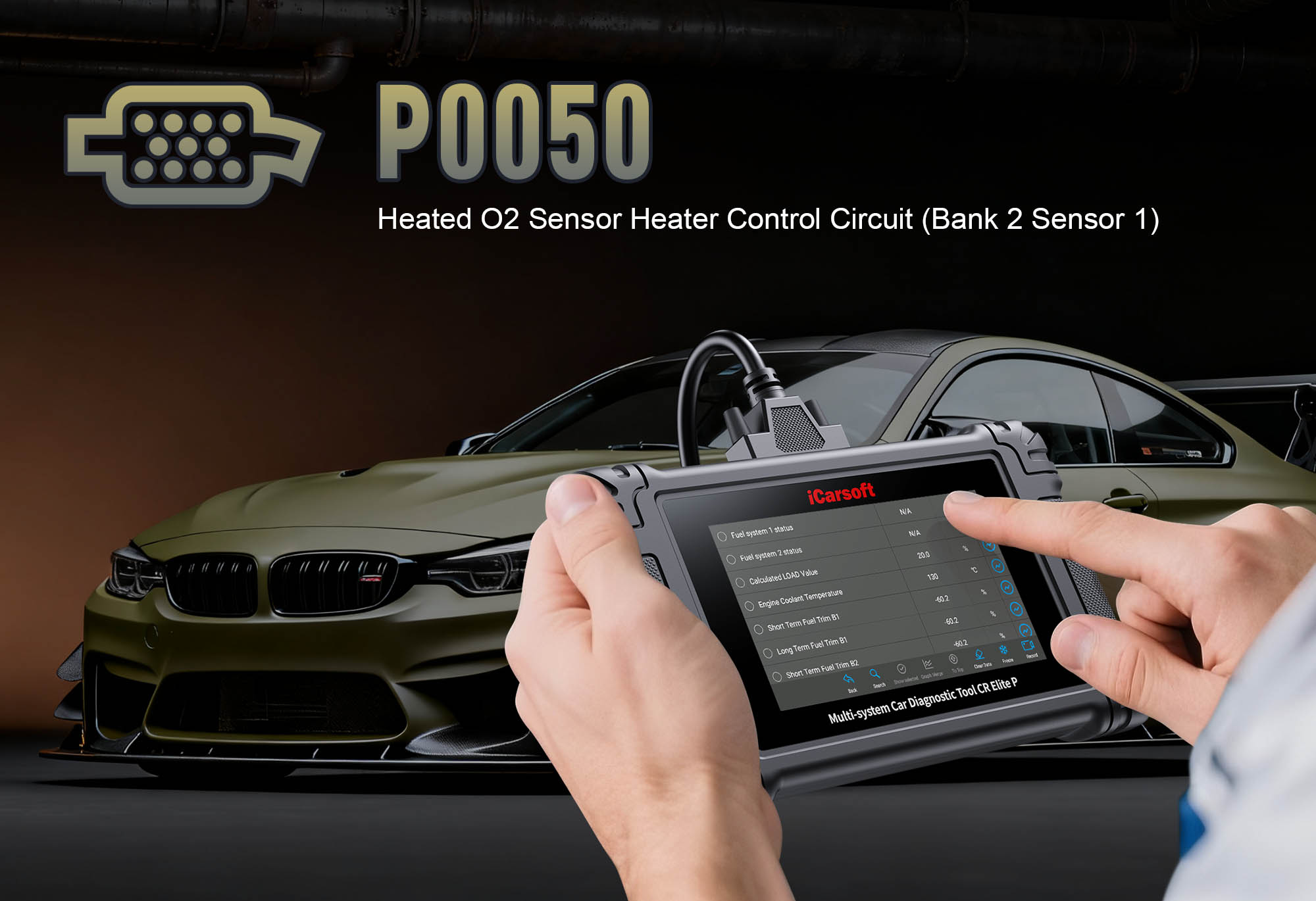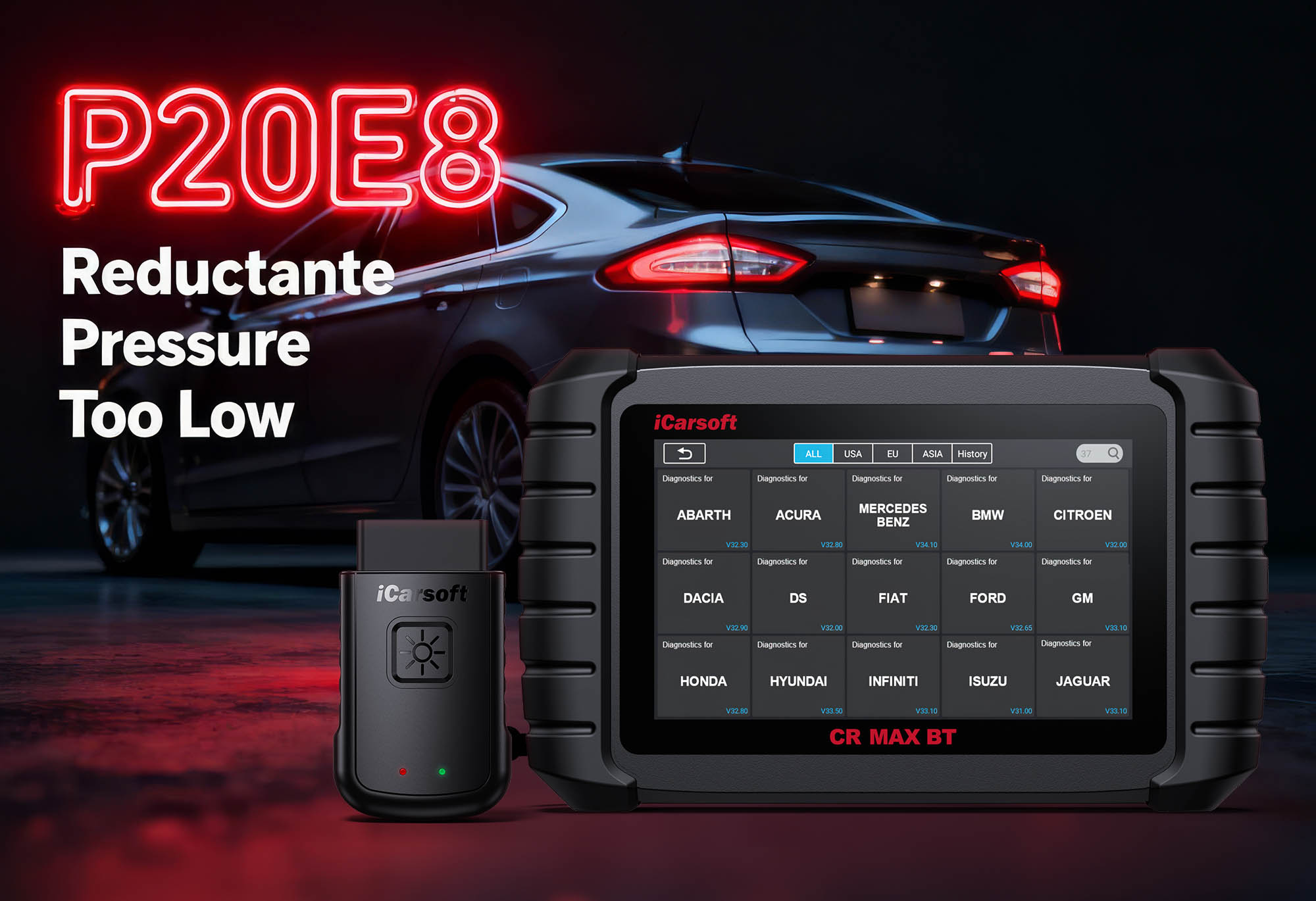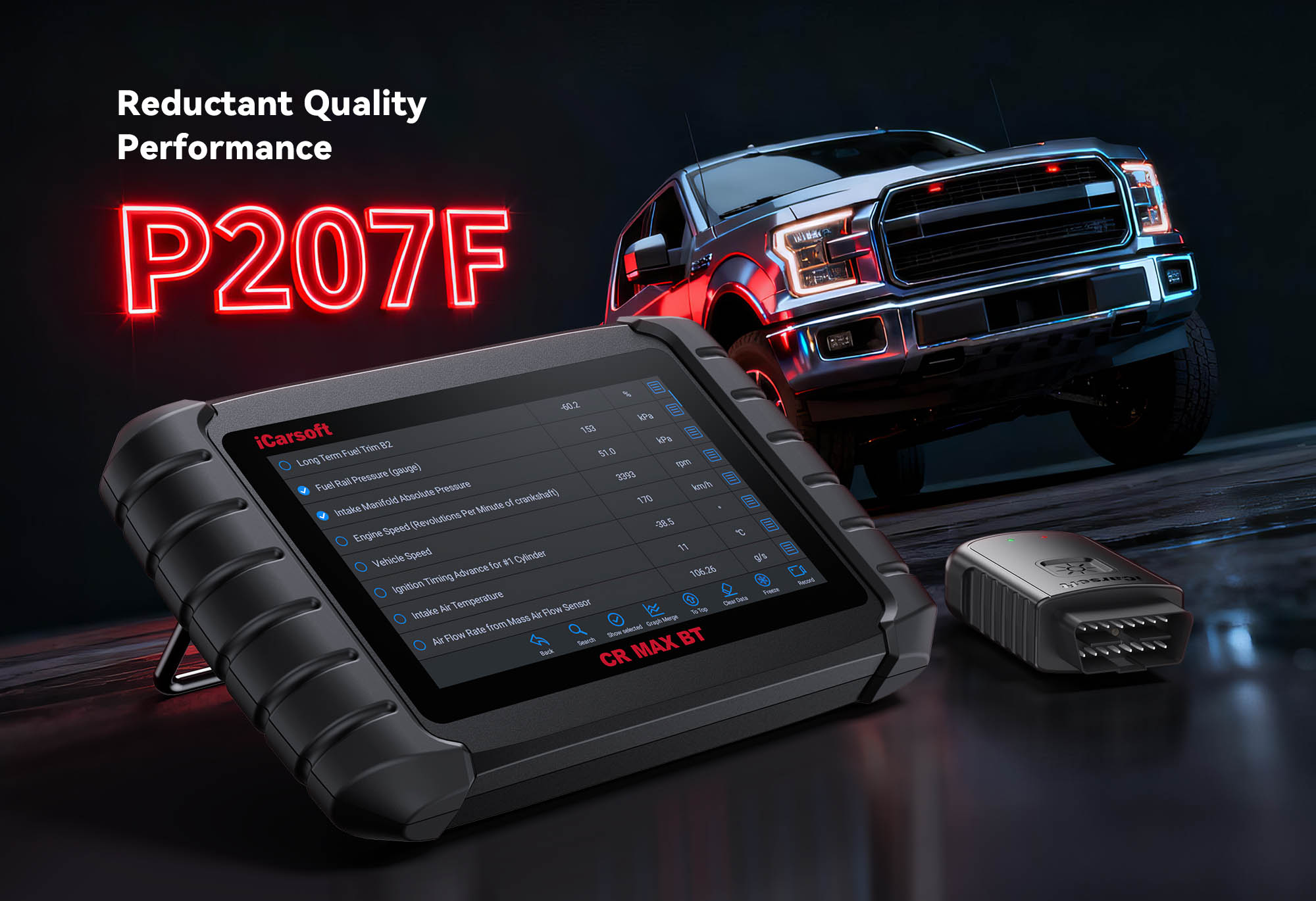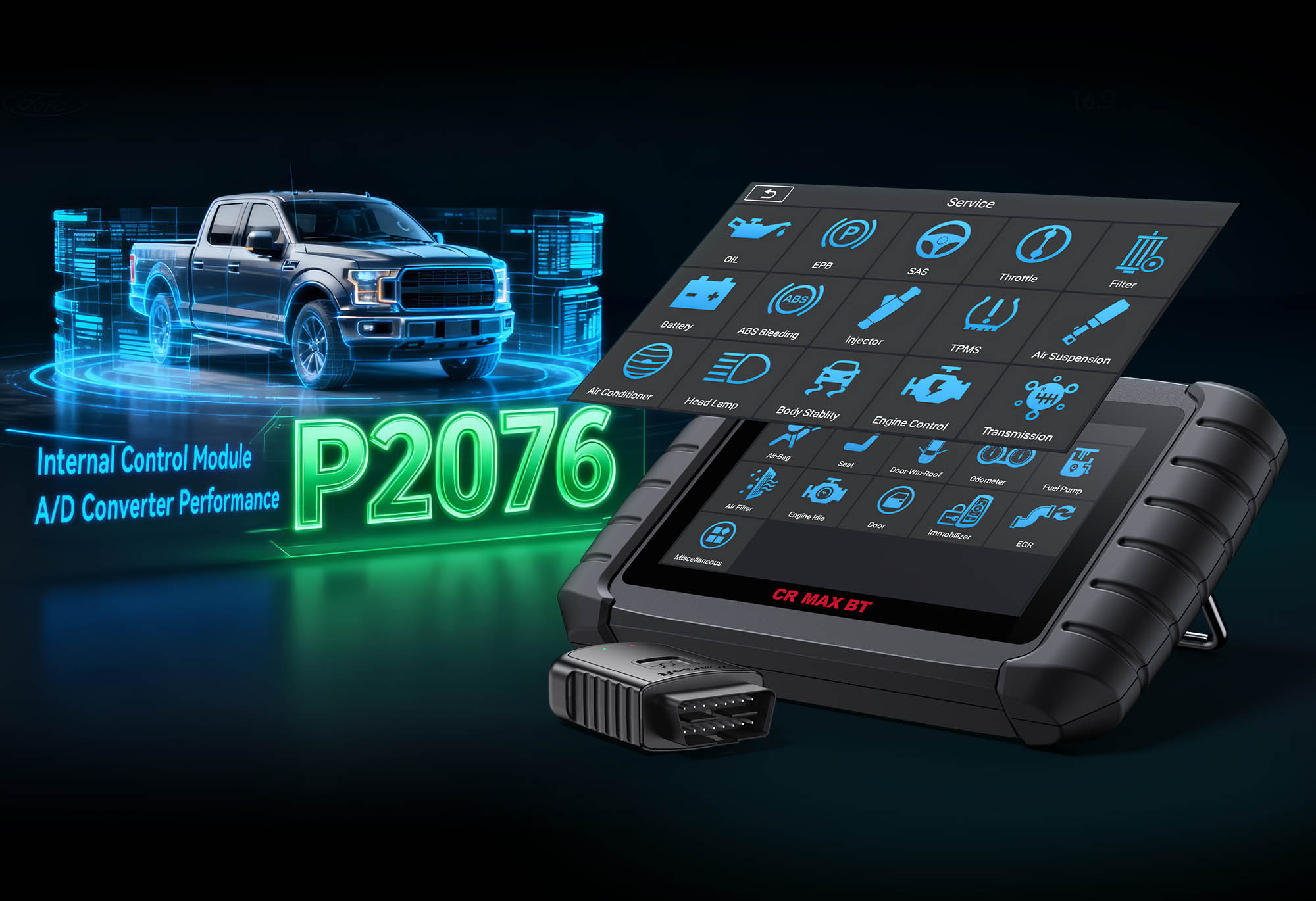Diagnose & Clear P0050 with iCarsoft CR Elite P: Fix O2 Sensor Heater Control Circuit (Bank 1, Sensor 2)
When your check engine light turns on, fuel efficiency drops, or your vehicle fails an emissions test, a scan may return P0050. This OBD-II code stands for "Oxygen (O2) Sensor Heater Control Circuit – Bank 1, Sensor 2"—a malfunction in the heating system of the downstream O2 sensor (after the catalytic converter) on Bank 1. The sensor’s heater is critical for maintaining its operating temperature (600–800°F/315–427°C), ensuring accurate monitoring of catalyst efficiency. A faulty heater circuit disrupts emissions control, risks catalyst damage, and increases fuel use over time.
Basic scanners only flag "sensor heater fault" but can’t test circuit voltage, isolate wiring issues, or verify ECM signals. The iCarsoft CR Elite P solves this with specialized O2 sensor diagnostics, live voltage tracking, and circuit tests. Below is a step-by-step guide to diagnosing and fixing P0050 accurately.
Understanding P0050: Symptoms & Common Causes
The Bank 1, Sensor 2 O2 sensor (downstream) sits in the exhaust pipe after the catalytic converter. Its job is to check if the catalyst is reducing emissions by comparing exhaust gases to the upstream (Bank 1, Sensor 1) sensor. The heater ensures it works quickly—even in cold weather—and stays active. P0050 triggers when the ECM detects irregularities (open/short circuits, voltage fluctuations) in the heater circuit.
Key Symptoms of P0050
-
Check Engine Light (CEL): Steady illumination, often with "Fuel System" or "Emissions" dashboard warnings.
-
Reduced Fuel Efficiency: Without accurate post-catalyst data, the ECM may use a rich fuel mixture—mileage drops by 10–15%.
-
Failed Emissions Tests: The downstream sensor is critical for emissions monitoring; a malfunction guarantees high hydrocarbon (HC) or carbon monoxide (CO) levels.
-
Catalytic Converter Overheating: Prolonged rich mixtures (from sensor errors) can overheat the catalyst, leading to costly damage or replacement.
-
Intermittent Acceleration Hesitation: Some vehicles show hesitation as the ECM struggles to adjust fuel delivery without valid sensor data.
Common Causes of P0050
|
Cause
|
Description
|
|
Faulty Bank 1, Sensor 2 O2 Sensor
|
The heater element burns out (common after 80,000–100,000 miles), preventing the sensor from reaching operating temperature.
|
|
Damaged Heater Circuit Wiring
|
Frayed wires, corrosion, or rodent chew marks disrupt voltage flow—exacerbated by heat from the exhaust pipe near the downstream sensor.
|
|
Loose/Corroded Sensor Connector
|
The 4/5-pin connector (near the exhaust) develops corrosion or loosens, breaking the heater circuit’s electrical connection.
|
|
Blown O2 Sensor Heater Fuse
|
A dedicated "O2 Heater" fuse (in the under-hood fuse box) blows, cutting power to the downstream sensor’s heater.
|
|
ECM Heater Driver Malfunction
|
Rarely, the ECM’s internal driver (controls heater voltage) fails, preventing proper power supply to the circuit.
|
Why iCarsoft CR Elite P Excels at Diagnosing P0050
The CR Elite P outperforms basic tools with features tailored to downstream O2 sensor heater diagnostics:
Live Heater Circuit Voltage Monitoring
Tracks real-time voltage in Bank 1, Sensor 2’s heater circuit (~11–12V when active). Instantly identifies low/high voltage or fluctuations.
Heater Circuit Integrity Tests
Checks for open circuits, shorts, or high resistance in power/ground wires—pinpoints wiring faults near the hot exhaust (a common issue for downstream sensors).
Bi-Directional Heater Control
Sends direct commands to activate/deactivate the heater, verifying if the ECM communicates with the downstream sensor (rules out ECM driver issues).
AutoVIN Identification
Automatically detects vehicle make/model and downstream sensor type (4-wire/5-wire/wideband), ensuring accurate specs for 500+ models (Ford, Toyota, Honda).
Sensor Age & Mileage Tracking
Uses odometer data to提醒 if the downstream sensor is past its service life (80,000–100,000 miles), prioritizing replacement before failure.
Fuse & Relay Locator
Guides you to the exact location of the O2 heater fuse/relay, simplifying checks for blown components (a top cause of P0050).
Step-by-Step: Diagnose P0050 with iCarsoft CR Elite P
-
1. Locate the Bank 1, Sensor 2 O2 Sensor
First, find the downstream sensor (critical for accurate checks):
-
Navigate to Component Location > Engine > Exhaust System > O2 Sensors > Bank 1, Sensor 2 on the CR Elite P.
-
Bank 1 = cylinder bank with cylinder #1 (driver’s side in most vehicles). Sensor 2 = after the catalytic converter (look for a sensor in the exhaust pipe downstream of the catalyst).
-
Note: The downstream sensor is closer to the rear of the vehicle—allow the exhaust to cool completely before touching it (prevents burns).
-
2. Initial Visual Inspection
Check for obvious issues (focus on exhaust heat-related damage):
-
Inspect the Connector: Look for corrosion (white/green deposits), bent pins, or looseness. Clean with electrical contact cleaner; resecure loose plugs.
-
Examine Wiring: Follow the harness from the sensor to the ECM—check for heat damage (melted insulation), frays, or rodent chew marks (common near the exhaust).
-
Check the Heater Fuse: Use Fuse Guide to find the "O2 Heater" fuse (under-hood box). Replace with same-amperage fuse (10A/15A) if the filament is broken.
-
3. Connect CR Elite P & Confirm P0050
-
Plug the tool into the OBD-II port. Power on and select AutoVIN Identify—detects engine type, sensor config, and ECM software.
-
Navigate to Engine > Fault Codes > Read Codes to confirm P0050. Tap Code Details for vehicle-specific insights (e.g., "Honda Civic: O2 Heater Circuit Fault (Bank 1, Sensor 2); Check Wiring or Sensor").
-
4. Monitor Live Heater Circuit Data
Real-time data reveals circuit behavior:
-
Start the engine and idle 5 mins (allows ECM to activate the downstream sensor’s heater).
-
Navigate to Engine > Live Data > O2 Sensors > Bank 1, Sensor 2 > Heater Voltage.
-
Normal operation: 11–12V when heater is active (cold starts), 0V when inactive. Abnormal signs:
-
Constant 0V = no power (check fuse/wiring/ECM).
-
Fluctuating voltage = loose connector or damaged wire.
-
5. Test Heater Circuit Integrity
Use the CR Elite P’s multimeter to check electrical health:
-
Turn off the engine (ensure exhaust is cool). Disconnect the Bank 1, Sensor 2 connector (press the tab to release).
-
Power Wire Test: Set multimeter to "DC Voltage." Touch one lead to the heater power pin ("Heater +" via Pinout Guide) and the other to chassis ground. Ignition "ON": Should read 11–12V. 0V = blown fuse/broken wire.
-
Ground Wire Test: Set multimeter to "Ohms." Touch one lead to the heater ground pin ("Heater -") and the other to chassis ground. Resistance <1 ohm = normal; >5 ohms = poor ground (clean/replace ground strap).
-
6. Test the O2 Sensor Heater Element
If wiring is intact, the sensor may be faulty:
-
Resistance Test: With connector disconnected, set multimeter to "Ohms." Touch leads to the two heater pins (not signal pins—refer to Sensor Diagram). Normal: 10–40 ohms (varies by brand). Infinite resistance = heater burned out.
-
Heater Activation Test: Reconnect the sensor. Navigate to Special Functions > Engine > O2 Heater Control > Bank 1, Sensor 2. Command "ON":
-
Good: Hear a faint "hiss" (heater warming) and voltage jumps to 12V.
-
Faulty: No hiss/voltage = replace the sensor.
-
7. Repair & Clear P0050
Fix the root cause based on diagnostics:
-
Blown Fuse: Replace with OEM-compatible fuse (same amperage).
-
Wiring/Connector Issues: Repair heat-damaged wires with heat-shrink tubing; clean connectors with dielectric grease (resists future corrosion).
-
Faulty Sensor: Replace with OEM-equivalent downstream sensor (use Part Lookup—e.g., Bosch 17464 for Ford, Denso 234-4630 for Toyota). Torque to 18–22 ft-lbs (avoids thread damage).
-
ECM Malfunction: Consult a dealer for reprogramming/replacement (last resort—rule out all other causes first).
Clear the code: Navigate to Engine > Fault Codes > Clear Codes and confirm P0050 is deleted.
-
8. Validate the Repair
Ensure the fix works long-term:
-
Monitor Live Data: Confirm heater voltage cycles correctly (11–12V active, 0V inactive) during a cold start.
-
Test Drive: Drive 20–30 mins (include cold starts and highway driving) — check for no CEL recurrence.
-
I/M Readiness Test: Run via OBDII Functions to verify emissions system compliance (critical for passing state inspections).
Preventing P0050 Recurrence
Use the CR Elite P to maintain downstream O2 sensor health:
-
Regular Circuit Checks: Set Service Reminder to test the Bank 1, Sensor 2 heater circuit every 30,000 miles—catch wiring damage early.
-
Heat-Resistant Wiring Protection: Wrap the sensor’s harness in heat-resistant loom (near the exhaust) to prevent insulation melting.
-
Connector Maintenance: Apply dielectric grease to the connector annually—blocks moisture and road salt that cause corrosion.
-
Timely Sensor Replacement: Replace downstream O2 sensors every 80,000–100,000 miles (use the CR Elite P’s mileage alert to stay on track).
Conclusion
P0050’s downstream O2 sensor heater fault may seem minor, but it risks costly catalyst damage and failed emissions tests. The iCarsoft CR Elite P simplifies diagnosis with targeted tools—no more guessing between wiring, fuses, or sensors. By focusing on the unique challenges of downstream sensors (exhaust heat, hard-to-reach locations), this tool ensures you fix the root cause efficiently.
For DIYers and pros alike, the CR Elite P’s O2-specific features, global coverage, and intuitive interface make it the best tool for resolving P0050. Restore emissions compliance, improve fuel economy, and protect your catalytic converter—all with one professional-grade diagnostic tool.
FAQs About P0050
Q: What’s the difference between P0050 (Bank 1, Sensor 2) and P0031 (Bank 1, Sensor 1)?
A: P0050 affects the downstream sensor (after the catalyst, monitors catalyst efficiency), while P0031 affects the upstream sensor (before the catalyst, adjusts fuel mixture). Both are heater faults but impact different parts of the emissions system.
Q: Can I drive with P0050 long-term?
A: Short trips (to a shop) are safe, but long-term driving risks catalyst overheating/damage (from rich fuel mixtures) and failed emissions. Fix P0050 within 100 miles to avoid costly repairs.
Q: How much does a downstream O2 sensor replacement cost?
A: Parts cost $60–$250 (OEM sensors are more reliable). Labor adds $80–$150 if you don’t DIY (downstream sensors are sometimes harder to reach). The CR Elite P saves by confirming the sensor is faulty before replacement.
Q: Why does P0050 come back after sensor replacement?
A: Unresolved issues like heat-damaged wiring, a blown fuse, or a poor ground. Use the CR Elite P’s circuit integrity test to check the harness near the exhaust—this is a common hidden fault for downstream sensors.





